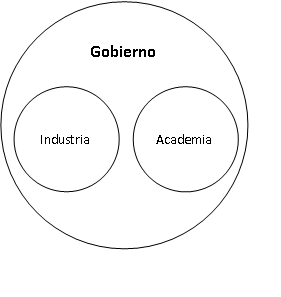

Cooperativismo y Desarrollo, January-April 2019; 7(1): 5-25
Translated from the original in Spanish
Analysis of collaboration networks in innovation for development
Análisis de las redes de colaboración en la innovación para el desarrollo
Maidelyn Díaz Pérez1, Rosalba Casas Guerrero2, Raudel Giráldez Reyes3
1Departamento de Publicaciones Científicas. Universidad de Pinar del Río "Hermanos Saíz Montes
de Oca'. Cuba. Email: maidelyn@upr.edu.cu
2Instituto de Investigaciones Sociales Universidad Nacional Autónoma de México. México. Email: rcasas@sociales.unam.mx
3Departamento de Publicaciones Científicas. Universidad de Pinar del Río "Hermanos Saíz Montes de Oca". Cuba. Email: giraldez@upr.edu.cu
Received: January 29th, 2019.
Accepted: February 4th, 2019.
ABSTRACT
The interest in developing research aimed at solving specific problems of society, has gradually generated a change in the ways of doing research. Today, methodological instruments are needed to obtain more data about the context where innovations are made, to know the: social context (researchers and institutions), the geographic (countries, cities, regions), the temporal context (time series), the thematic context (areas of knowledge where research has been developed), the relational and participatory context (collaborations and triple helix relationships established in the development of innovations). Therefore, the objective of this research is to apply the Triple Helix model approach to the analysis of the behavior of an innovation domain, based on a case study. Techniques and metric indicators are used for the analysis of information, adapting the methodological procedure to the analysis of social networks. The relevance of this research is the possibility of applying the entity, collaboration, as a unit of analysis and measurement to know the knowledge networks that are established in the development of innovations; besides being able to identify data coming from the innovations that allow to describe some innovative scenarios, as well as certain linking mechanisms that are established in the endogenous developments. What transcends this research is the possibility that shows to be able to apply this methodological approach to different levels of aggregation and in different domains of analysis, which can range from national programs to specific research projects for cooperation.
Keywords: collaboration; cooperation for development; innovative knowledge networks; Triple Helix model; linking channels in innovation; local development and cooperatives.
RESUMEN
El interés por desarrollar investigaciones orientadas a resolver problemas concretos de la sociedad ha ido generando paulatinamente un cambio en las formas de hacer investigación. Hoy se precisan instrumentos metodológicos que permitan obtener más datos sobre el contexto donde se realizan las innovaciones, conocer: el contexto social (investigadores e instituciones), el contexto geográfico (países, ciudades, regiones), el contexto temporal (series cronológicas), el contexto temático (áreas del conocimiento donde se han desarrollado las investigaciones), el contexto relacional y participativo (colaboraciones y relaciones triple hélice que se establecen en el desarrollo de las innovaciones). Por ello, el objetivo de esta investigación consiste en aplicar el enfoque del modelo Triple Hélice para el análisis del comportamiento de un dominio de innovación, a partir de un caso de estudio. Se utilizan técnicas e indicadores métricos para el análisis de la información adaptando el proceder metodológico al análisis de redes sociales. Lo relevante de esta investigación es la posibilidad de aplicar la variable colaboración, como unidad de análisis y medida para conocer las redes de conocimiento que se establecen en el desarrollo de innovaciones; además de poder identificar datos procedentes de las innovaciones que permiten describir algunos escenarios relevantes, así como determinados mecanismos de vinculación que se establecen en los desarrollos endógenos. Lo que trasciende en esta investigación es la posibilidad que muestra de poder aplicar este enfoque metodológico a diferentes niveles de agregación y en diferentes dominios de análisis, los que pueden ser desde programas nacionales hasta proyectos específicos de investigación para la cooperación.
Palabras clave: colaboración; cooperación para el desarrollo; redes de conocimiento innovador; modelo Triple Hélice; canales de vinculación en la innovación; desarrollo local y cooperativo.
INTRODUCTION
Collaborare, in Latin to collaborate, means to work with another person or other people in the realization of a work. In the Dictionary of the Spanish Language is the action and effect of collaborating. In the field of research, this action has always been perceived as the joint relationship between two or more scientists sharing data, ideas and experiments during research projects, exchanges of experiences, consultancies, scientific events, among others.
Rogers (2000) analyses trends in the development and evolution of the phenomenon of collaboration. For him, the centre of analysis should be the different forms of organization of Research and Development (R&D) activities within the projects, since the definition of theoretical structures for understanding the dynamics and results of research will depend to a large extent on this. According to the literature, these can occur from Knowledge Value Alliances (KVAKnowledge Value Alliances), or arise from Knowledge Value Collectives (KVCKnowledge Value Collective). Collectives appear as a set of individuals connected by the use of a particular body of information for the generation of knowledge; while alliances are formed by sets of collectives in which there are diverse individuals interacting directly from multiple institutions, each of them contributing with resources in the pursuit of transcendent knowledge goals (Rogers, 2000).
There are also research alliances, based on cost economy, and alliances based on purely strategic aspects (Hemphill & Vonortas, 2003) that strive to explain the behavior of collaborating parties. Organizational Theory and Management focus on analyzing strategic incentives for collaboration. The analysis of these theories gravitates mainly in trust and power, where collaboration is encouraged by these factors to establish networks. Another stimulus for collaboration is the dependence on resources, tangible or intangible, that are linked to the parties and whose exchange or commercialization with other organizations of the environment is a necessity. In other words, the exclusive relationships that an organization has are part of its competitive position.
UNESCO, at the international level, research the relationships in the scientific and technological development of countries, encouraging integration in research and the search for generalizable solutions to the most pressing problems facing localities today. However, it does not use a methodological procedure that allows it to characterize and measure the different contexts in which these advances and innovations are developed. In its reports, it only offers macro figures and very general behaviors of the innovations in the different countries. At the regional level, the Network of Ibero-American Science and Technology Indicators (RICYT) is the leading organization in charge of standardizing studies on results in science and technology. But considering this research, the RICYT hinders the visualization of the true innovative performance of Latin American countries, since it does not apply indicators that allow it to measure the behaviors and contexts that have influenced the development of technological innovations in the different regions.
In academic and research contexts, collaboration in science can be conceptualized as the research effort made by groups of researchers from different disciplines (interdisciplinary collaboration), either belonging to the same country (national collaboration) or to more than one country (international collaboration), to institutions within a country (national institutional collaboration) or to individuals within a country or across those borders (collaboration between individual authors) (Urbizagástegui Alvarado & Restrepo Arango, 2011). The aforementioned author states that collaboration and teamwork have become the means par excellence to integrate knowledge and skills that encourage the processes of research and innovation.
This research shares the criterion that scientific collaboration is an implicit particularity of all science, technology and innovation systems, and that it should be considered one of its greatest strengths, based on living together in a society that advocates the democratization of scientific knowledge. The focus of the national innovation systems has the purpose of forming networks that generate environments that stimulate innovation and technological change, in the same way that they promote relations among all the actors involved in this process. In this type of system, research is the result of knowledge that is created in the context of application and where transdisciplinarity of scientific fields prevails in the work teams.
The nineties marked a greater depth in the studies aimed at researching the relationships between science, technology, state and society. Several initiatives arise that analyze the relationships between these instances and their behavior, reaching the largest number of scientific followers the model called Triple Helix (TH). From the first reflections, this model addresses the complex and blurred limits between academia, the institutional environment where the infrastructure of academic knowledge is executed and the evolutionary analysis of the base of that knowledge in the economy of a government or of the State.
The TH model manages three environments: the generation of wealth (industry or company), the production of novelty (academia) and public control (government). Its main objective is to understand and interpret the relations between University-Business-Government (Etzkowitz & Leydesdorff, 2000). The following is a summary of the variants that evolved from the TH model.
Triple Helix I (Figure 1) is the state model of university-industry-government relations. In this configuration the government of the nation encompasses academia and industry and directs the relations between them (specific historical situation). The solid version of this model could be found in the former Soviet Union and Eastern European countries under the "existing socialism". Weaker versions were also formulated in the policies of several Latin American countries and, to some extent, in European countries such as Norway.

Fig. 1. - Triple Helix Model I
Variant II of the policy model (Figure 2), laissez-faire, consists of separate institutional spheres with well-defined boundaries that divide them, with highly circumscribed relationships between these spheres. This is exemplified in Sweden, according to the Research 2000 Report, and in the United States, contrary to several reports of the Government University Industry Research Roundtable (GUIRR) of the National Research Council.
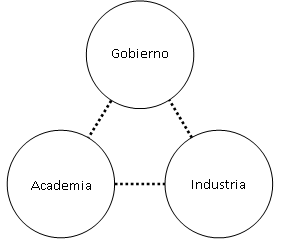
Fig. 2. - Triple Helix Model II
Variant III of the Triple Helix model of University-Industry-Government Relations (Figure 3) generates a knowledge infrastructure in terms of overlapping institutional spheres, each taking on the role of the other, with hybrid organizations emerging at the interfaces.
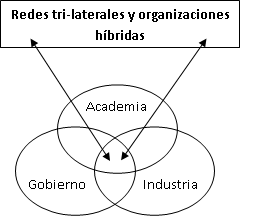
Fig. 3. - Triple Helix Model III
After analysis, this research agrees with Leydesdorff (1987) in considering that Triple Helix I is seen as a failed development model. Having very little coverage for "grassroots" initiatives, it is inferred that it discourages innovation rather than stimulating it.
The Triple Helix II establishes a laissez-faire policy, now also defended as shock therapy, to reduce the role of the state in the Triple Helix I. In one way or another, most countries and regions are trying to achieve some form of Triple Helix III. The common goal is to obtain an innovative environment consisting of university spin-off firms, trilateral initiatives for knowledge-based economic development, and strategic alliances between firms (large and small, operating in different areas and with different levels of technology), government laboratories, academic research groups, among others.
The innovation sources in a Triple Helix model stop being synchronized a priori (Leydesdorff, 1987). They do not fit together in a pre-established order, but generate enigmas for participants, analysts and policy makers to solve. This network of relationships generates a reflexive subdynamic of intentions, strategies, and projects that add value by continuously reorganizing and harmonizing the underlying infrastructure to achieve at least one approximation of goals (Etzkowitz & Leydesdorff, 2000).
The Triple Helix provides a heuristic for the study of complex dynamics related to the evolution of institutional networks among knowledge carriers (Leydesdorff & Meyer, 2006). In this regard, this research shares the view that there are different possible solutions between the university, industry and government that can help generate complementary strategies for economic growth and social transformation. Most countries and regions are now trying to achieve some kind of Triple Helix, with the common goal of carrying out an innovative environment that involves all the desired factors to advance and grow from the three perspectives.
The analytical model of the Triple Helix, proposed by Etzkowitz & Leydesdorff (2000), goes beyond wanting to reflect University-Industry-State relations; it is a model that shows the dynamics, evolution, transition and change of these relations. This model also indicates how these relationships are managed by individuals and groups that make decisions. Under this approach, each part is related to the other two, and an emerging overlap of communications, networks, and organizations can be expected to develop from this. In this way, innovation occurs in a non-configured order, there are only new arrangements of participants that under changing strategies, actions and projects, continuously reorganize and harmonize the existing infrastructures in order to reach or approach the proposed goals.
In the Cuban case, the lack of information to work with this model constitutes a significant limitation in the development of different social studies on the understanding and description of innovation processes, mainly in local development contexts (Díaz Pérez, 2009). There are not enough instruments to identify with real pertinence the different mechanisms of linkage that consist in the generation of certain innovations, nor can it be identified the developments and technologies that were generated in a framework of triple helix relations, or under any other form of collaboration; even identify the construction of knowledge networks between different actors. Por ello, el objetivo de esta investigación consiste en aplicar el enfoque del modelo Triple Hélice para el análisis del comportamiento de un dominio de innovación, a partir de un caso de estudio.
In this research, the domain being analyzed (Cuba's patents) is not the most important thing; what is relevant is the possibility of applying a new methodological procedure that uses collaboration as a unit of analysis and measurement to get to know the knowledge networks established in the development of innovations; in addition to being able to identify data from the innovations that make possible to describe some relevant scenarios, as well as certain linkage mechanisms that are established in endogenous developments. The important thing is to be able to apply this methodological approach at different levels of aggregation and in different domains of analysis, which can range from national programmes to specific research projects for cooperation.
MATERIALS AND METHODS
Information source: The World Intellectual Property Organization (WIPO) is the institution that uses patent analysis par excellence to offer its studies of trends, technological monitoring, prospective studies and industrial market, among others (Bonino, Ciaramella & Corno, 2010; Fabry, Ernst, Langholz & Köster, 2006; Fattori, Pedrazzi & Turra, 2003). Patents are considered in the present research units of technological capacity because they represent technological knowledge, identifying them as variables of study, computation and measurement. As a source of data, the patents granted by the Cuban Industrial Property Office of Cuba (OCPI), published in its Official Gazette, are selected.
Search strategy: all patents registered in the OCPI and published in its Official Gazette between the dates 01-01-1997 and 31-12-2008; that is, in a period of twelve years, were downloaded on a non-profit basis. Of this total of patents, only those documents that had all the information requested in the obligatory fields of the patent were entered into the database.
Levels of analysis aggregation: the bibliographic data obtained from patent processing were grouped according to different variables: temporal, thematic, geographical and collaborative.
Time Distribution: the time period analyzed by this research is a 12-year time series, framed between 1997 and 2008.
Data processing: proINTEC software is used for downloading, standardization, processing, analysis and visualization of data from the patent document. Software with proven and contrasted reliability in different international studies (Díaz Pérez et al., 2014; Moya Anegón, Chinchilla-Rodríguez, Corera-Álvarez & Díaz Pérez, 2012; Pérez Arreortúa, Díaz Pérez, Giráldez Reyes & Carrillo-Calvet, 2014).
Analysis techniques: the networks presented in the form of nodes or vertices, where the semantic structure is defined by the links or relations that connect these nodes, are used as a data analysis and visualization technique. Visualization through networks makes it possible to represent the network connections, cross variables are used to identify patterns that underlie the innovation networks and describe the most significant behaviors of each technological context.
Representation and visualization of the information in network: for the analysis and interpretation of the data the information is visualized in the form of technological maps using the Pathfinder algorithm, because it allows to show only the most relevant links of the mapped networks. It is used as a pruning technique the numerical delimitation of the intensity of the relations in those nodes whose relation is weak. For the positioning of the nodes the spatial representation algorithm Spring Embedded and Netdraw are used to manipulate the graphics in the visual representations.
RESULTS AND DISCUSSION
Case study: collaborative networks between innovations (co-titling)
Co-titling is considered to be the union of two or more companies, universities and persons in the financing and possession of a patent under the category of owner or owner of the technology. In this study, the co-titling relationships that are mostly established are of a horizontal type or between institutions acting on the same blade of the propeller, although there are also collaboration networks for innovation between institutions of different blades of the propeller (Graph 1).
The University of Havana is one of the institutions with the greatest collaborative results in the period under analysis; it maintains collaboration with the University of the East and with the Research Centre for the Mining-Metallurgical Industry. Another of its most notable relationships is the triangulation established between the Universidad de Oriente, the Instituto de Ciencia Animal and the Centro de Investigaciones en Bioalimentos, as well as the repeated collaborations between the Universidad de la Habana and the Universidad de Oriente, existing between them the strongest research relations between the Academy.
Innovations obtained from collaboration between academies:
The National Biopreparations Center is the institution that has worked most collaboratively (Graph 1); it is considered the holder with the greatest potential to establish collaborative research relationships.
Innovations obtained in collaboration with:
An analysis of graph 1 shows that the IGBC worked in collaboration with the "Pedro Kourí" Institute in the generation of technologies, as well as the Forestry Research Institute in collaboration with the Higher Institute of Nuclear Science and Technology.
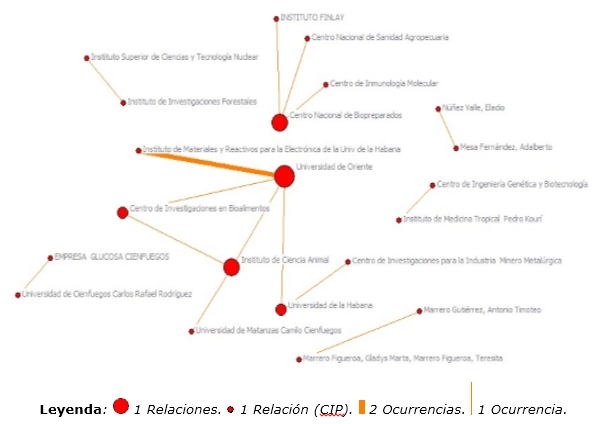
Graph 1. - Co-titling networks in Cuban innovations
Source: proINTEC
software
Another of the co-titles within the study considered as very significant are the collaborations that take place in Cuba between the University-Enterprise spheres, an example of this is:
Case Study: Innovation Networks
This study analyses the behaviour of innovation networks from the perspective that there are different types of networks in the context of innovation. In this case, we will now analyze the spaces and networks that are built between innovative research actors for the development of certain technologies.
Graph 2 shows the actors who have researched together on more than two occasions to develop innovations, some of them establishing up to six collaborative relationships in the development of different technologies. Several research groups that work together in the generation of innovations in Cuba are represented.

Graph 2. - Coinvention in Cuba
Source: proINTEC software
A very illustrative example of collaboration between actors is established between universities, with some examples below:
In this study, it was found that co-invention analysis can indicate the main fronts of technological research being carried out in a country.
The analysis of the data allowed to identify the origin of the researchers, in this case it is corroborated that the holder CIGB that has more patents, also possesses researchers with high productivity, which corresponds with its positioning in the national innovative context. In turn, these data document the results obtained in the application of empirical techniques. This center has developed a scientific-technological policy articulated with the mechanisms of industrial property protection, developing research projects that have conceived technological strategies with the obtaining of patentable results with high stability. This has allowed the construction of an innovative entrepreneurial scenario, based on developing a stable technological trajectory with the introduction of competitive technologies in the international market.
Case Study: Triple Helix Ratio (University-Business-Government)
This study considered significant the results of the application of the Triple Helix approach to the analysis of the innovative Cuban context, due to the characteristics of the social, economic and political model of the country. All patent holders were processed and classified by origin according to the National Statistics and Information Office (ONEI) in: University-Business-Government.
The analysis of the data allowed to know that the composition of the blades of the propeller in the innovation processes of Cuba is: 198 patents belong to the Government, 166 patents to Universities and 114 patents to Companies. The greatest relations are established between University-Government and University-Business, where the weakest relations are between Government-Business.
The results obtained allow us to infer that in the innovative Cuban context, public research centers (Universities) play a very important role in the social distribution of knowledge. In several of the analyses carried out, the participation of the Academy in the generation of knowledge for its introduction into society stands out. It is true, as recognized authors affirm, that universities fulfill an important social responsibility as promoters of the economic and social development of the regions (Casas Guerrero, 2002) and approach, therefore, to new forms in the production of knowledge, characterized as Mode 2 (Gibbons & Johnston, 1974).
These results, together with those obtained in the interviews, reveal that in Cuba the knowledge coming from the Academy is taken as a premise for the development of many important technologies. But the idea is always to look for articulated solutions between academia, business and government to strengthen the innovation processes directed from the different ministries and organs of the central administration of the state.
The technological knowledge sectors were also analyzed, where the efforts of the three sectors (University-Business-Government) for the generation of certain technologies have been articulated (Table 1). In the case of technological innovations developed between the University-Business-Government, the technologies that have been generated the most are mainly destined for sector C (Chemistry) and sector A (Current Life Needs) of technological knowledge.
Table 1. - Patents for IPC section in Triple Helix
IPC |
Business |
Government |
University |
Total |
A |
24 |
100 |
49 |
173 |
B |
17 |
18 |
17 |
52 |
C |
41 |
86 |
69 |
196 |
D |
7 |
1 |
|
8 |
E |
7 |
1 |
|
8 |
F |
9 |
8 |
12 |
29 |
G |
7 |
20 |
24 |
51 |
H |
2 |
2 |
16 |
20 |
Total |
114 |
236 |
187 |
537 |
Source: proINTEC software
To learn more about the particularities of the technologies generated in TH, graph 3 shows the different clusters of technological knowledge, where the University, the Company and the Government work together. The center of the map represents the intensity of the thematic relations in Triple Helix, where some of the most worked thematic classes are:
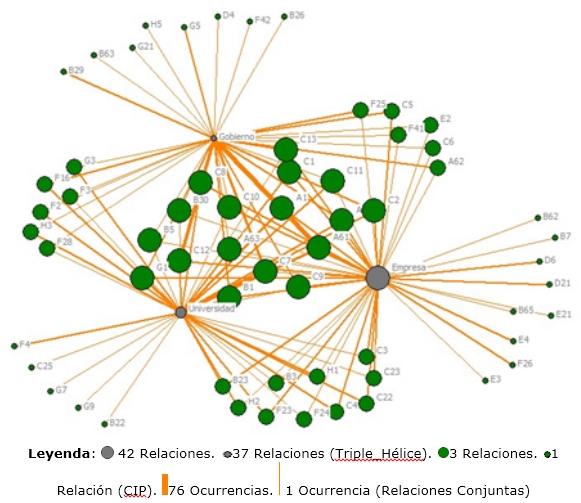
Graph 3. - Technological sectors where the University, the Company and the Government
work together
Source: proINTEC software
Below there are some of the main technologies developed in collaboration and introduced as important innovations in Cuban society (Table 2).
Table 2. - Example of inventions developed in collaboration
Index |
Patent Number |
Patent Title |
Patent Owner |
1 |
CU 23058 A1 |
PROCEDURE AND OBTAINING ANIMAL FEED FROM SLUDGE COMING FROM ANAEROBIC BIODIGESTORS OF ORGANIC RESIDUALS |
University of Oriente and Biofood Research Centre, the Institute of Animal Science and University of Oriente |
2 |
CU 22735 A1 |
PROCEDURE FOR OBTAINING BARIUM NITRATE FROM LIQUOR RESULTING FROM THE AQUEOUS LEACHING OF REDUCED BARITE. |
Institute of Materials and Reagents for Electronics of the University of Havana and The University of Oriente |
3 |
CU 22881 A1 |
CULTURE MEDIUM FOR MYCOPLASMA GROWTH |
National Center for Biopreparations and National Center for Agricultural Health |
4 |
CU 22979 A1 |
IMMUNOTHERAPEUTIC COMBINATION FOR THE TREATMENT OF OVER-EXPRESSING RECEPTOR KINASE ACTIVITY TUMORS IN TYROSINE RESIDUES |
Center for Molecular Immunology and National Center for Biopreparations |
5 |
CU 22983 A1 |
ALLERGY VACCINE COMPOSITION AND METHOD FOR OBTAINING AND USING IT IN THE TREATMENT OF ALLERGIES |
Finlay Institute and National Center for Biopreparations |
6 |
CU 23245 A1 |
CODING CHIMERIC CHAINS FOR VIRUS-INDUCING PROTEINS. PREPARATIONS USING CHIMERIC PROTEINS |
Center for Genetic Engineering and Biotechnology and Pedro Kourí Institute of Tropical Medicine |
7 |
CU 23274 A1 |
NICKEL AND COBALT RECOVERY PROCEDURE FOR AMMONIACAL COLAS |
University of Havana and Research Center for the Metallurgical Mining Industry |
8 |
CU 23120 A1 |
PROCEDURE FOR OBTAINING THERAPEUTIC ESSENTIAL OIL FROM THE FOLIAGE OF PINUS SP AND EUCALYPTUS SP |
Higher Institute of Nuclear Science and Technology and the Institute of Forestry Research |
9 |
CU 23179 A1 |
HYDROLYSING OF ALCOHOL DISTILLERÚAS BASINS WITH AN ENZYMATIC CRUDE OF THE BACILLUS LICHENIFORMES E-44 STRAIN AND ITS OBTENTION PROCESS. |
University of Matanzas Camilo Cienfuegos and the Institute of Animal Science |
10 |
CU 22863 A1 |
PROCEDURE OF REDUCTION OF THE ORE BARITINE TO BARIUM SULPHIDE WITH MICROWAVE ENERGY. |
Institute of Materials and Reagents for Electronics of the University of Havana and the University of Oriente. |
13 |
CU 23279 A1 |
DEVICE FOR MACHINING ECCENTRIC HELICAL SCREWS USING A UNIVERSAL MILLING MACHINE |
University of Cienfuegos Carlos Rafael Rodríguez and Glucosa Cienfuegos Company |
14 |
CU 22736 A1 |
PROCEDURE FOR OBTAINING BARIUM ACETATE FROM LIQUOR PRODUCT OF THE AQUEOUS LEACHING OF REDUCED BARITE. |
University of Oriente |
Source: proINTEC software
Case Study: International Collaboration with Cuba (co-titling and co-invention)
Graph 4 shows the countries that have worked together to protect patents in Cuba. The results of this analysis revealed that Cuba has maintained joint titling relations with Brazil, it only has one patent under co-ownership with another country. This collaboration is very discreet in comparison with the relations that the United States has with other countries.
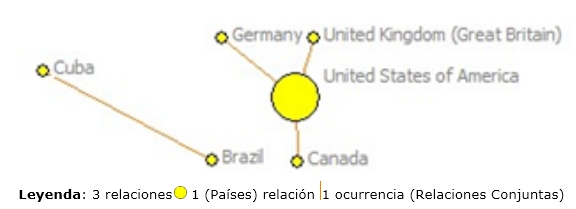
Graph 4. - Joint countries
Source: proINTEC software
By analyzing the joint holders of patents by country, it was possible to know that the Cuban institution that maintains relations with Brazil is the Higher Institute of Nuclear Science and Technology. It was also learned that the collaborations in innovations between different countries are oriented to the following topics:
When analyzing the collaboration relations between inventors, that is, when analyzing the country of origin of the researchers involved in the development of the technologies, it became known that Cuba, despite having only one joint patent with another country, does have a greater exchange of relations with researchers from other countries. In the period studied, Cuba maintains joint collaborative relations with researchers from 15 countries.
Graph 5 shows the origin of the inventors-actors who have worked jointly with Cuban researchers. It represents a broad collaboration among the actors that generate patents, corroborating Cuba's relations with actors from other countries such as: Spain, Mexico, Brazil, Germany, Canada, Argentina, etc.
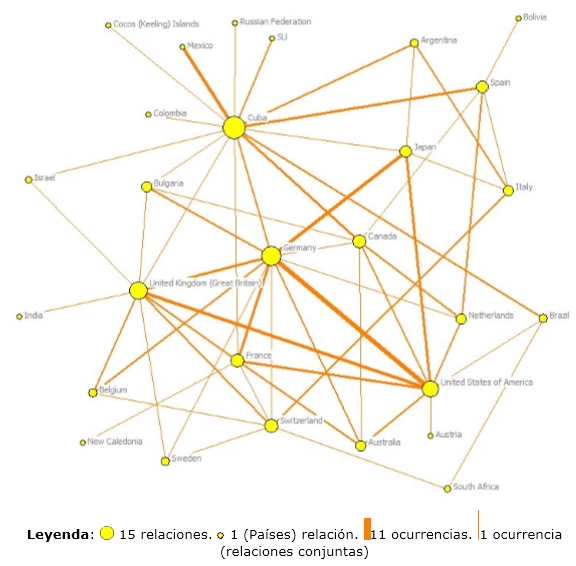
Graph 5. - Coinvention by country of origin
Source: proINTEC software
The analysis of the country's Detailed Knowledge Capture Capacity indicator obtained the data that the main countries that have participated in innovations developed in the country are:
In summary, this research considers that some of the factors that have led to collaboration in this case study are:
The case study showed, to a certain extent, the correspondence between the behaviour of this country and the new theoretical trends in innovation. Innovation as a system is a social process in which different actors and factors of different nature converge and interact in an environment that favours this integration, as well as the inclusion of each one of its parts and not its simple sum, obtaining from this systemic integration a new stage of development in the solution of society's problems.
In this case, the universities with the highest scientific production in Cuba correspond to those with the highest technological productivity or patents, which indicates that there are Cuban universities that close the cycle of research, development and innovation. Collective learning processes are built where knowledge flows from different environments, propitiating the transfer of knowledge and the creation of technological skills and capacities.
It was proven that, in the case of Cuba, there are relations between the University and Industry in order to generate and introduce new technologies into society. Part of the scientific-technological discoveries exhibited and commercialized today by the Cuban State at the international level are the result of these relations. Likewise, it was known that the best relations of the institutions classified as Government are with universities.
Cuba shows a high capacity to retain and capture technological knowledge, with a skillful patenting strategy that safeguards the protection of technological innovations developed under international collaboration.
The analysis of Cuba's patents allowed to understand that this country has a high technological development, with high scalability of its innovations in the national and international market because it bets the limited financial resources it has, its main researchers and research infrastructures, to solve specific problems of Cuban society and the world.
This research also showed Cuba's technological development (patents) in the biotechnology sector, achieved by the high qualification and professionalism of its human resources (inventors-researchers), the scientific and technical rigor of its infrastructures (owners), science and technology policies (State), work guidelines, norms and regulations (Ministries). It is estimated that it can be considered a sectorial innovation system according to the current integral and inclusive perspective of what an innovation system should be.
The thematic analysis of Cuban patents revealed that this country does not innovate in what each researcher wants, but in the priorities established by the country in its different sectors by ministries. This strategy for the development of science and technology has allowed it to optimize human, financial and infrastructure resources, orienting them to the problems and priorities of today's society.
In short, this research leaves in black and white the need to apply this type of methodological procedure to domains of innovation in order to describe the different collaborative relationships that occur in these scenarios. More pragmatic methodological instruments are needed to obtain more data on the context in which the innovations are carried out, mainly the one:
In the light of the above, this research raises a number of questions that leaves open to further research, for example: Is it valid to use the collaboration indicator as a unit of measure to identify the cooperation relationships that influence the generation of innovations in local contexts?; Could the Triple Helix approach be the model that best represents the linkage mechanisms established in endogenous community developments?
REFERENCES
Bonino, D., Ciaramella, A. & Corno, F. (2010). "Review of the state-of-the-art in patent information and forthcoming evolutions in intelligent patent informatics". World Patent Information, 32(1), 30-38. https://doi.org/10.1016/j.wpi.2009.05.008
Casas Guerrero, R. (2002). "Redes regionales de conocimiento en México". Comercio Exterior, 52(6), 1-16. Recuperado a partir de http://revistas.bancomext.gob.mx/rce/magazines/23/3/RCE.pdf
Díaz Pérez, M. (2009). "Situación de las metodologías para la medición de la ciencia, la tecnología y la innovación en América Latina". ACIMED, 19(4).
Díaz Pérez, M., Guzmán Sánchez, M. V., Giráldez Reyes, R., Armas Peña, D., Rodríguez Font, R. J. & Carrillo Calvet, H. A. (2014). "Tuberculosis, Bacillus Calmette-Guérin (BCG) y vacunas de tuberculosis: análisis de patentes". Revista Cubana de Información en Ciencias de la Salud, 25(3), 259-269. Recuperado a partir de http://scielo.sld.cu/scielo.php?script=sci_abstract&pid=S2307-21132014000300002&lng=es&nrm=iso&tlng=es
Etzkowitz, H. & Leydesdorff, L. (2000). "The dynamics of innovation: from National Systems and «Mode 2» to a Triple Helix of university-industry-government relations". Research Policy, 29(2), 109-123. Recuperado a partir de https://econpapers.repec.org/article/eeerespol/v_3a29_3ay_3a2000_3ai_3a2_3ap_3a109-123.htm
Fabry, B., Ernst, H., Langholz, J. & Köster, M. (2006). "Patent portfolio analysis as a useful tool for identifying R&D and business opportunitiesan empirical application in the nutrition and health industry". World Patent Information, 28(3), 215-225. https://doi.org/10.1016/j.wpi.2005.10.004
Fattori, M., Pedrazzi, G. & Turra, R. (2003). "Text mining applied to patent mapping: a practical business case". World Patent Information, 25(4), 335-342. Recuperado a partir de https://ideas.repec.org/a/eee/worpat/v25y2003i4p335-342.html
Gibbons, M. & Johnston, R. (1974). "The roles of science in technological innovation". Research Policy, 3(3), 220-242. https://doi.org/10.1016/0048-7333(74)90008-0
Hemphill, T. & Vonortas, N. (2003). "Strategic Research Partnerships: A Managerial Perspective". Technology Analysis & Strategic Management, 15(2), 255-271. https://doi.org/10.1080/0953732032000051145
Leydesdorff, L. (1987). "Various methods for the Mapping of Science". Scientometrics, 11, 291-320.
Leydesdorff, L. & Meyer, M. (2006). "Triple Helix indicators of knowledge-based innovation systems: Introduction to the special issue". Research Policy, 35(10), 1441-1449. https://doi.org/10.1016/j.respol.2006.09.016
de Moya Anegón, F., Chinchilla-Rodríguez, Z., Corera-Álvarez, E. & Díaz Pérez, M. (2012). Estudio de la producción científica y tecnológica en colaboración universidad-empresa en Iberoamérica. Oleiros, La Coruña: Netbiblo.
Pérez Arreortúa, N., Díaz Pérez, M., Giráldez Reyes, R. & Carrillo-Calvet, H. A. (2014). "Content analysis of the technological domain vegetable oil combustion". Transinformação, 26(3), 327-338. https://doi.org/10.1590/0103-3786201400030009
Rogers, J. D. (2000). "Theoretical Consideration of Collaboration in Scientific Research". En Strategies for competitiveness in academic research. American Association for the Advancement of Science.
Urbizagástegui Alvarado, R. & Restrepo Arango, C. (2011). "Modelando la distribución del número de coautores por artículo". Investigación bibliotecológica, 25(53), 103-119. Recuperado a partir de http://www.scielo.org.mx/scielo.php?script=sci_abstract&pid=S0187-358X2011000100005&lng=es&nrm=iso&tlng=es
